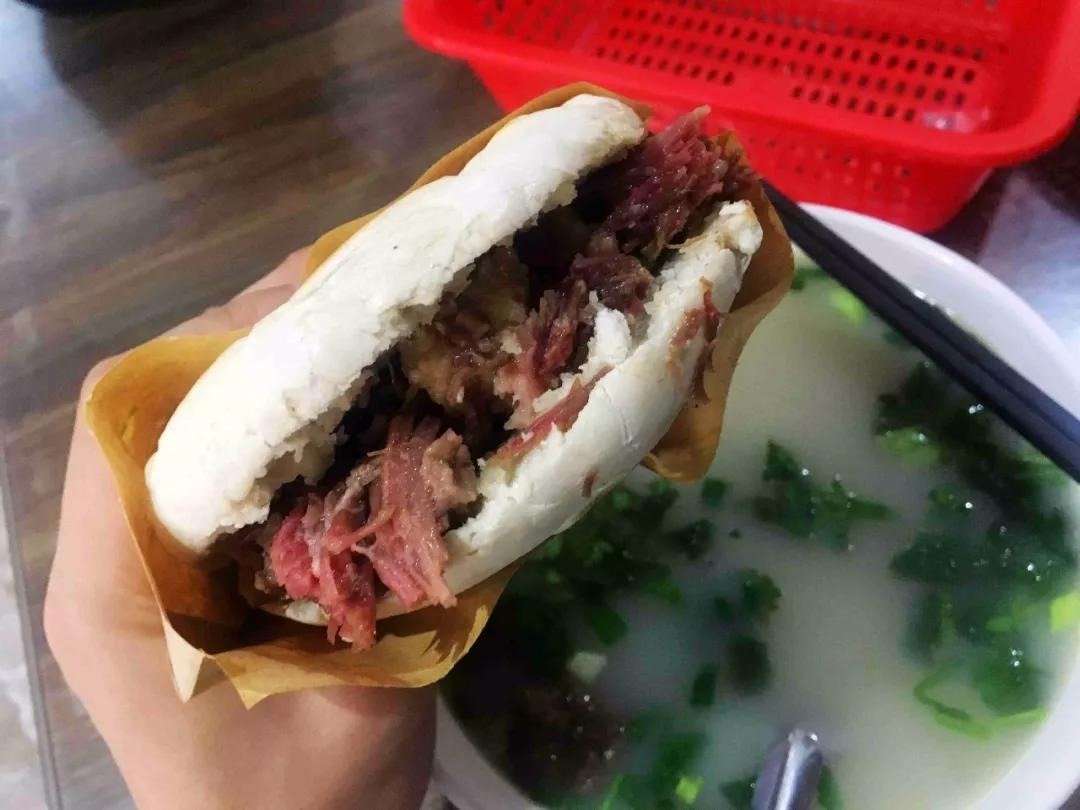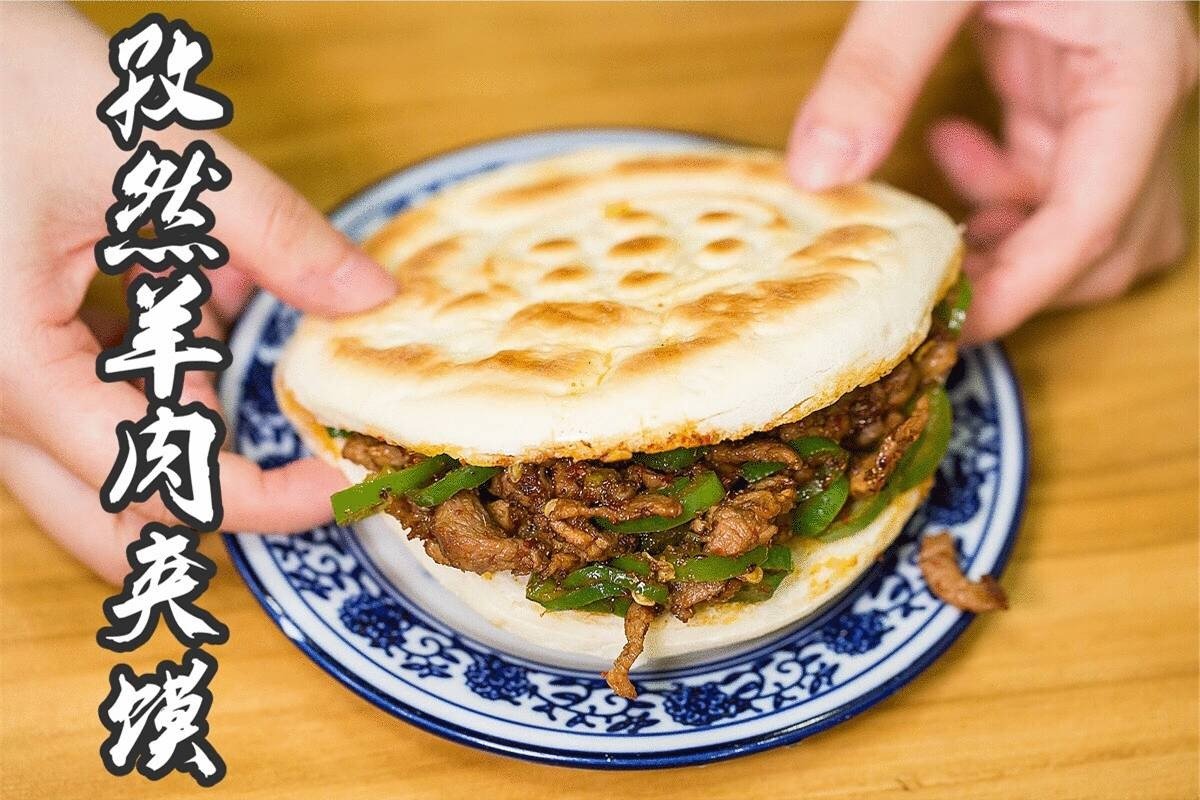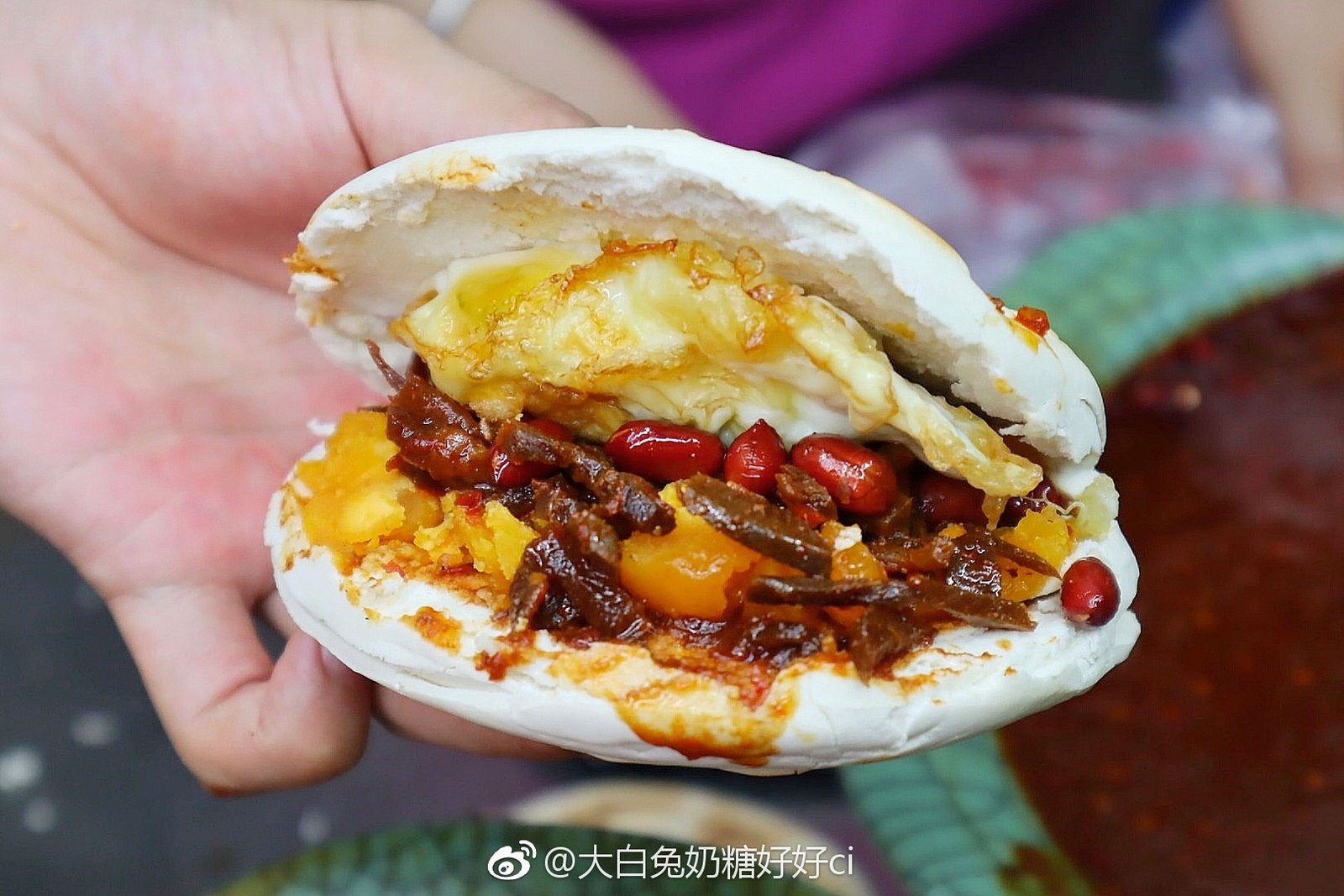Xi’an Roujiamo comes in a variety of types, and here are some common ones:
Traditional Cured Meat Roujiamo(传统腊汁肉夹馍)
Features: This is the most classic type of Roujiamo. It uses pork stewed in a special cured meat marinade, resulting in meat that is tender and soft, with lean parts that are not dry and fatty parts that are not greasy, exuding a rich and mellow meat aroma. The bread, known as Baijimo, has a crispy exterior and a soft, fluffy interior, with a puffed-up surface resembling an “iron ring, tiger’s back, and chrysanthemum heart.” The stewed cured meat is finely chopped and stuffed into the freshly baked Baijimo. The bread absorbs the rich aroma of the meat juices, while the meat is further enhanced by the bread, creating a perfect harmony of flavors.
Production Process: To make the cured meat, pork is placed into a seasoned broth made with a variety of spices and simmered over low heat for several hours or even longer, allowing the meat to fully absorb the flavors of the broth. The Baijimo is made by kneading flour with water, yeast, and other ingredients to form a dough, which is then proofed, shaped, and baked through a series of steps.

Cured Beef Roujiamo(腊牛肉夹馍)
Features: This variety primarily uses beef as the main ingredient. The beef is marinated and then cooked in a seasoned broth, resulting in a firm, chewy texture with a savory and delicious taste, showcasing the unique flavor of beef. It is paired with Baijimo or other types of flatbread, where the wheat aroma of the bread blends harmoniously with the savory richness of the beef, creating a rich and satisfying taste experience.
Production Process: The curing of the beef is quite meticulous, involving a variety of seasonings and a lengthy marinating process to ensure the beef is thoroughly infused with flavor. The cooking process requires careful control of heat and timing to achieve the ideal texture and flavor of the beef.

Cumin Roujiamo(孜然肉夹馍)
Features: This variety typically uses tender pork or chicken, sliced thinly or cut into small pieces, marinated with cumin, chili powder, salt, cooking wine, and other seasonings, then stir-fried or grilled on an iron plate. The meat boasts a rich cumin aroma and a subtle spiciness, with an enticing fragrance that stimulates the appetite. It is paired with Baijimo or other types of flatbread, such as shaobing, where the texture of the bread complements the fragrant and spicy cumin-infused meat, creating a unique and delightful flavor.
Production Process: After marinating the meat to infuse it with flavor, it is quickly stir-fried or grilled at high heat, allowing the cumin and other seasonings to fully permeate the meat. This process also creates a slightly charred surface on the meat, enhancing its overall flavor profile.

Minced Meat Roujiamo(臊子肉夹馍)
Features: This variety typically uses pork, cut into small cubes, and stir-fried with chili, vinegar, scallions, ginger, garlic, and other seasonings. The meat cubes are bright red in color, offering a tangy and spicy flavor. When stuffed into the bread, the tangy and spicy minced meat complements the simple wheat aroma of the bread, creating a balanced and layered taste that is both appetizing and satisfying.
Production Process: The pork is first diced into small cubes and stir-fried in hot oil until the fat is rendered. Then, various seasonings and an appropriate amount of water are added, and the mixture is simmered over low heat. This allows the meat cubes to fully absorb the flavors of the seasonings until they are thoroughly cooked and the sauce becomes thick and rich.

Potato Chip Roujiamo(土豆片夹馍)
Features: This is a relatively novel and popular variation of Roujiamo, especially among younger people. Thinly sliced potatoes are fried until golden and crispy, and can be paired with ingredients like lettuce and spicy strips according to preference. These are then stuffed into a crispy baked bread, and brushed with a special sauce. The result is a rich and varied texture, combining the crispy and fragrant potatoes, the refreshing crunch of lettuce, and the spicy kick of the spicy strips, all brought together by the flavorful sauce.
Production Process: After slicing the potatoes, careful attention is paid to the frying temperature and time to ensure the potato chips achieve a crispy texture. The bread is typically baked in an oven or on a griddle until the surface is golden and crispy. The sauce is a blend of various seasonings, carefully mixed to enhance and harmonize the flavors of the filling.

Egg and Vegetable Roujiamo(蛋菜夹馍)
Features: This variety features eggs and various pickles and sauces as the main fillings. The eggs are either fried sunny-side up or scrambled, and then paired with rose pickles, crushed peanuts, chili oil, and other ingredients, all stuffed into the bread. The result is a rich and diverse texture, combining the tender smoothness of the eggs, the savory aroma of the rose pickles, the crunchy texture of the crushed peanuts, and the spicy kick of the chili oil. The flavors are robust and the dish is nutritious.
Production Process: The eggs are cooked according to different methods, while the rose pickles are typically prepared in advance through a pickling process. The crushed peanuts are obtained by roasting and then grinding the peanuts. The various ingredients are stuffed into the bread in a certain ratio, and chili oil or other sauces are added according to personal taste preferences.







